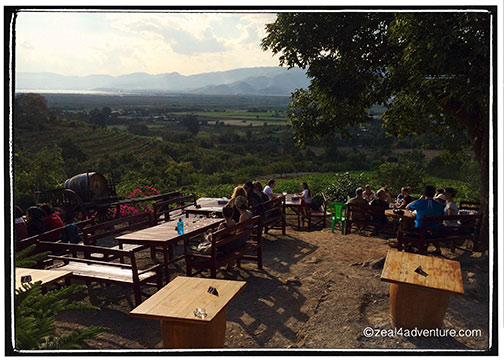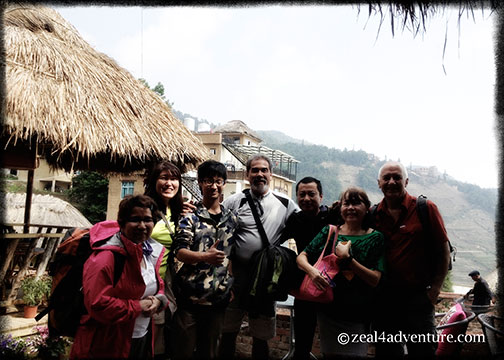 Though still pretty much under the radar, this sleepy town is fast becoming a foodie and adventure destination. On our way to Penang, we stopped by Ipoh in Perak to see what some travel enthusiasts are raving about. We arrived on a Sunday and lo and behold, half of Ipoh was indeed asleep. Shops and quite a few restaurants were closed.
Though still pretty much under the radar, this sleepy town is fast becoming a foodie and adventure destination. On our way to Penang, we stopped by Ipoh in Perak to see what some travel enthusiasts are raving about. We arrived on a Sunday and lo and behold, half of Ipoh was indeed asleep. Shops and quite a few restaurants were closed.

Steep limestone cliffs flank the capital of Perak, some with cave temples pocketed in the limestone. The state of Perak has much to offer regarding outdoor activities such as white water rafting and jungle treks. Although we skipped that as a previous injury prevented such activities, for now, we will perhaps go back one of these days to explore that part of Perak.

We spent the two days centered on the food and exploring the old town with a side trip to Batuh Gajah, just 30 minutes out of Ipoh.
Ipoh is shaped by the 1920s tin-mining boom, its wealth and population however ebbed away after the mine’s closure. It is now better known for its excellent food. Perak’s most beautiful colonial architecture stands side by side with shabby coffee shops.

We had a blast sampling their food specialties and discovering some fine street arts that scatter around town.
Nga Choy Kai
The first thing we did was to sample Ipoh’s quintessential dish that is bean sprout chicken or Tauge Ayam.

It is essentially kway teow (flat rice noodle) soup,

poached juicy and tasty chicken and the most delicious beansprout I’ve had.

Lou Wong’s, as recommended by the hotel and some reviews, serves one of the best. As with many of the traditional eateries in Ipoh, Lou Wong was unpretentious with round tables and stools and no aircon. We were there early, but the place was packed not long after we were seated.
Street Art

Wandering through the lanes of Ipoh’s old town reveals a scattering of stencil art murals. Some quirky and easily spotted while others are subtly woven into the streetscape.

A few were done to decorate establishments. While there are some pieces done by Zacharevic, the mural artist that started Penang’s street art scene, other artists have joined in the scene as well.
Han Chin Pet Soo Museum
A guided tour of the museum will provide a good insight into the history of the Chinese in Ipoh. Originally the house of the Hakka Tin Mining Club founded in 1893.

The unique museum has on display artifacts, collectibles, and photographs from the 19th and 20th century. This gives you a chance to step back in time and see how the Hakka tin miners were tempted and tormented by the 4 evils, which were Opium, Gambling, Prostitution, and Triad.

The founder, Leong Fun, arrived in Penang penniless in 1876. With a lot of luck and hard work, he found success in the tin mining industry. Since “Towkay” Leong Fu found the exclusive membership club, it has always been a place of mystery to non-members. Although it has opened its doors to the public now, the entry remains to be special as it is by appointment only.
Appointments can be made via the website or by queuing at the door.
Ho Yan Hor Museum

This two-story shophouse is right beside the Han Chin Pet Soo Museum and belongs to the Ho Family of the famous Chinese Herbal tea brand, Ho Yan Hor. Following the successful restoration of next door neighbor, Han Chin Pet Soo, the family decided to open the shop after it was left vacant for so many years and had ipohWorld run its tours.

Also steeped in history, the visit will reveal the brand’s rise to popularity. Complimentary teas for tasting cap the end of the tour.
Concubine Lane
 Concubine Lane in between the two structures as seen from the balcony of Han Chin Pet Soo.
Concubine Lane in between the two structures as seen from the balcony of Han Chin Pet Soo.
The same “towkays,” mining tycoon Yao Tet Shin, in particular, said to have given away 3 lanes as gifts to his 3 wives. These are Wife lane, Concubine Lane, Second Concubine Lane.

Concubine Lane or the 1st Concubine Lane is the one that has transformed into a hip street in Ipoh with cafes, boutique hotels, food, and souvenir stalls.

Kellie’s Castle

Two days is really not enough to explore all of Perak. With the limited time that we had, we decided to pay Kellie’s Castle a visit.

The unfinished ruined mansion built by a Scottish rubber plantation owner named William Kellie Smith is located just 30 minutes away from Ipoh. The castle has Scottish, Moorish, and Indian influences and had multiple passageways.
 A replica of what the living could have been.
A replica of what the living could have been.
It was intriguing and eerie to wander around the ruins. It was never completed because Smith suddenly died of pneumonia in Lisbon. His wife, Agnes later packed up and left Malaysia with her children and never returned.

She sold the castle to a British company. The only thing left of the home is the covered walkway, an open courtyard, and part of a crumbling wall. Kellie’s castle has been refurbished and was even used as a set in the 1999 film Anna and the King.
A friend mentioned that a foodie will always find their way to Ipoh and Penang, but I say that a non-foodie who loves adventure and history will find Ipoh to be worth a visit. But definitely go for the food.









 Chinese Pork Adobo
Chinese Pork Adobo Ulang in Sate Sauce
Ulang in Sate Sauce





 Once an important trading hub, the British East India Company established spice farms throughout the island. The export of these spices helped cover the administrative cost of Penang in its early years.
Once an important trading hub, the British East India Company established spice farms throughout the island. The export of these spices helped cover the administrative cost of Penang in its early years.
























 Though still pretty much under the radar, this sleepy town is fast becoming a foodie and adventure destination. On our way to Penang, we stopped by Ipoh in Perak to see what some travel enthusiasts are raving about. We arrived on a Sunday and lo and behold, half of Ipoh was indeed asleep. Shops and quite a few restaurants were closed.
Though still pretty much under the radar, this sleepy town is fast becoming a foodie and adventure destination. On our way to Penang, we stopped by Ipoh in Perak to see what some travel enthusiasts are raving about. We arrived on a Sunday and lo and behold, half of Ipoh was indeed asleep. Shops and quite a few restaurants were closed.











 Concubine Lane in between the two structures as seen from the balcony of Han Chin Pet Soo.
Concubine Lane in between the two structures as seen from the balcony of Han Chin Pet Soo.



 A replica of what the living could have been.
A replica of what the living could have been.
















 we arrived at the outdoor seating at the top of the hill, overlooking the sprawling vineyard of the estate and Inle Lake shimmering in the distance – a view that could almost pass as Spain, France or Italy.
we arrived at the outdoor seating at the top of the hill, overlooking the sprawling vineyard of the estate and Inle Lake shimmering in the distance – a view that could almost pass as Spain, France or Italy.

 Because we’ve had lunch already, we got desserts to go with the wine.
Because we’ve had lunch already, we got desserts to go with the wine.






 A popular stall to warm the body and soul.
A popular stall to warm the body and soul.










































































